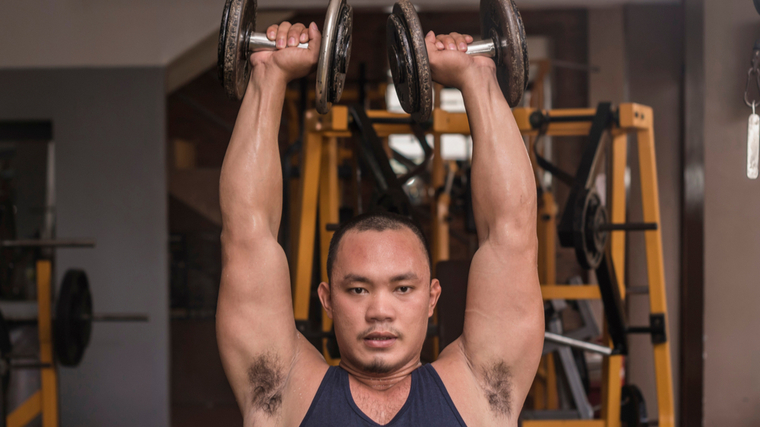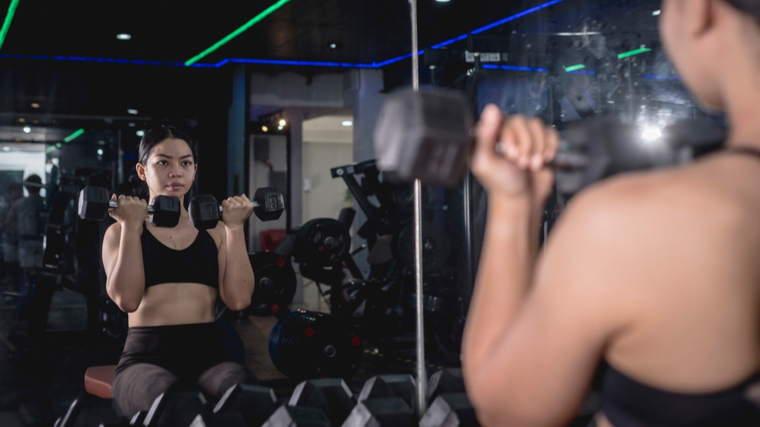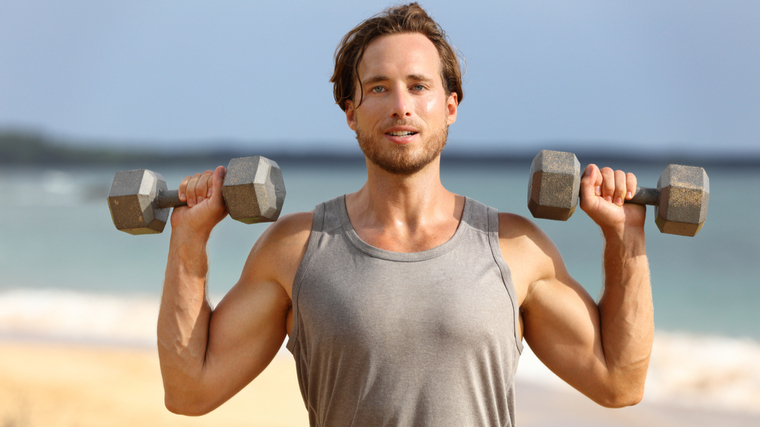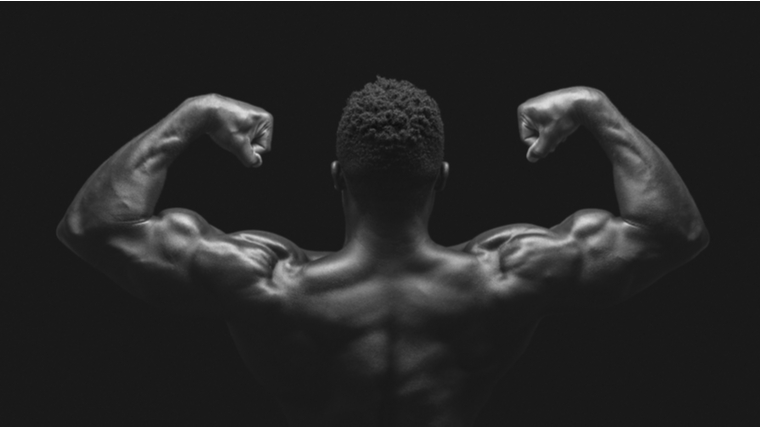An exercise’s name doesn’t usually hold too much value beyond summarizing what it is or how it’s done. The bench press has you lying on a bench while pressing. The barbell row has you, well, rowing a barbell. Squat’s gonna squat. But when a specific exercise variation is named after an individual lifter or coach, … Read more
The post How to Do the Arnold Press for Fully Developed Shoulders appeared first on Breaking Muscle.
An exercise’s name doesn’t usually hold too much value beyond summarizing what it is or how it’s done. The bench press has you lying on a bench while pressing. The barbell row has you, well, rowing a barbell. Squat’s gonna squat.
But when a specific exercise variation is named after an individual lifter or coach, it’s usually an indicator that the movement is next-level and should be used accordingly. John Meadows’ Meadows row, Glenn Pendlay’s Pendlay Row, Steve Romania’s Romanian deadlift (Kidding. Although, the more accurate “Nicu Vlad deadlift” would sound pretty cool, too.)
When it comes to eponymous shoulder training, the Arnold press is named after the quintessential bodybuilder of all bodybuilders — the Austrian Oak, the Governator, Arnold Schwarzenegger. Here’s an in-depth look at this delt-builder from the seven-time Mr. Olympia.
- How to Do the Arnold Press
- Arnold Press Mistakes to Avoid
- Benefits of the Arnold Press
- Muscles Worked by the Arnold Press
- Who Should Do the Arnold Press
- How to Program the Arnold Press
- Arnold Press Variations
- Arnold Press Alternatives
- Frequently Asked Questions
How to Do the Arnold Press
The Arnold press is a variation of the standard seated overhead dumbbell press. It uses a different path of resistance and longer range of motion to recruit more muscles into the exercise.
Step 1 — Get Into the Starting Position

Sit on a bench with a dumbbell in each hand, resting on your thighs with a thumbs-up grip. “Kick” the weight straight up to rest the thumb-side of each weight on the fronts of your shoulders. When both weights are up, slightly lower your elbows and rotate your hands to have your palms facing your mouth.
You should almost be in the top position of a curl, with your arms fully bent and your pinkies facing each other. Keep your shoulder blades pulled back, don’t allow the weights to pull your body forward.
Form Tip: Pretend you’re extra-shy and focus on covering your mouth with the weights in this position. This is a good target for the bottom position and will help to encourage a full stretch and complete range of motion.
Step 2 — Press and Rotate

In a coordinated motion, begin pressing the weights up and back while gradually rotating your hands and arms. As the weights move overhead, your elbows should come to the sides in-line with your shoulders and your palms should turn to face forward.
Continue pressing the weights entirely overhead, bringing them together at the top. In the locked out position, the weights should be nearly touching and your palms should be facing forwards, identical to a standard dumbbell overhead press.
Form Tip: Some lifters have trouble performing the necessary movements simultaneously. Perform the lift slowly and focus on blending the upwards and backwards movement while rotating your hands. The exercise should eventually feel smooth and natural.
Step 3 — Lower to Your Chin

From the locked out position, reverse the entire process. Bring the weights down while shifting your elbows to the front and rotating your palms towards your face. In the bottom position, the weights should again be in front of your mouth.
The bottom position should again resemble the top part of a curl with your arms bent and your palms facing your head.
Form Tip: Like the pressing motion, some lifters have trouble performing the movement in reverse order. Go slowly and focus on blending each step to bring your elbows down and forward.
Arnold Press Mistakes to Avoid
Because the Arnold press involves so many moving parts, there are several common technique mistakes which can reduce the effectiveness.
Rotating Your Hands, Not Your Arms
The Arnold press isn’t simply “turning your hands while you press the weight,” because turning your hands doesn’t necessarily change the angle of your shoulder, which means you’re not necessarily recruiting more parts of the deltoid (shoulder).

The upper arms, not just the hands and wrists, need to move during the press. Moving the upper arm, which is controlled by the shoulder and upper back, is what changes the pressing angle and increases muscle recruitment.
Avoid It: Make sure your elbows transition from pointing forwards (in the bottom position) to pointing to the sides (in the top position). Your hands should rotate as a natural side effect of shifting your elbows.
Using a Short Range of Motion
Performing an exercise with a short range of motion has been shown to build less size and strength compared to a full range of motion. (1) The extended range of motion of an Arnold press is one of its defining features, and cutting that range of motion short will significantly reduce its benefits.

Some lifters keep the weights at eye-level rather than lowering to their mouth, or they don’t rotate their elbows back in-line with their shoulders and instead keep them angled slightly forwards, or they may avoid locking out at the top. All of these are mistakes that can reduce the overall muscle-building stimulus.
Avoid it: Remember three key points: Get your hands in front of your face at the bottom, have your elbows in-line with your shoulders at the midpoint, and have the weights nearly touching at lockout.
Benefits of the Arnold Press
The Arnold press is named after one of the greatest bodybuilders of all time and it’s been used consistently for decades, so it’s going to be a “pretty good” choice for adding muscle.

Here are a few more reasons to add this complete muscle-builder to any upper body workout.
Long Range of Motion
Compared to the standard dumbbell shoulder press, the Arnold press extends the range of motion several extra inches. This added range increases the stretch, particularly on the front delt muscle, and is a strong stimulus for more growth.
Shoulder Size
The Arnold press is a serious delt-building exercise. The range of motion and long time under tension trigger muscle growth in the entire shoulder, specifically the front and side heads, with some assistance in the upper back and traps.
Muscles Worked by the Arnold Press
The Arnold press is primarily a shoulder exercise, but due to the weight’s path of motion, the upper back and even the biceps play a role in executing the movement.

By controlling the weights from in front of the body to the sides, muscles are recruited in a unique way, which requires a degree of shoulder and upper back mobility but also delivers more muscle growth.
Deltoids
The deltoids, or shoulders, are composed of three separate heads of the muscle — the anterior/front, lateral/side , and rear. Each head has a slightly different role dictated by the arm’s position relative to the body. The front delt lifts the arm in front of the body, the lateral delt controls the arm out to the side, and the rear pulls the arm back behind the body.
Due to the motion of the weights, the Arnold press recruits all three delt heads significantly, with increased emphasis on the front delts which work extremely hard when the weight is in the bottom position.
Triceps
The triceps are made of three separate heads — the long, the lateral, and the medial. While the lateral and medial heads attach to the upper arm, the long head connects to the scapulae (shoulder blades), with each head being recruited when the arm is in various positions relative to the body (down by your sides, straight in front of your body, overhead, etc.). (2)
The triceps become highly activated during the Arnold press when the weights are roughly ear-level and are recruited to press into the lockout position.
Biceps
The biceps, consisting of the long head and the short head, are involved in bending or flexing the arm as well as rotating the forearms. The long head, specifically, also plays a role in raising the upper arm in front of the body.
The biceps aren’t activated during standard shoulder presses, however, the Arnold press recruits the biceps as stabilizers to control the weight during the lower half of the exercise when the arm is bent and rotated into the overhead position.
Upper Back
The upper back is a collective term for multiple muscles running from shoulder to shoulder and around the shoulder blades, including the trapezius, teres major and minor, rhomboids, and rear deltoids.
The upper back provides stability during the press and is actively engaged to pull the arms backwards during the Arnold press.
Who Should Do the Arnold Press
The Arnold press is a relatively advanced shoulder press variation that can be used by any lifter who can master its performance.
Lifters Training to Build Muscle
The Arnold press puts the shoulder through a long time under tension, which is shown to be a significant factor for building muscle. (3) This intense exercise will add size to your shoulders, arms, and upper back.
How to Program the Arnold Press
The Arnold press can play a role in any muscle-building routine, especially as one of the first exercises performed in a shoulder-focused workout.
Moderate Weight, Moderate Reps
Training this classic bodybuilding exercise with a classic bodybuilding method of three to four sets of eight to 12 reps is a reliable plan to grow wider delts. Be sure to use a steady, or slightly slow, rep speed and take each set to thorough muscular fatigue.
Mechanical Drop Set Technique
One advanced muscle-building technique that can be very effective with the Arnold Press is mechanical drop sets. It’s a way to continue training a body part after reaching muscular failure on a specific exercise.
While traditional drop sets allow continued training by using a lighter weight, mechanical drop sets use the same weight and switch to a slightly less challenging, nearly identical, exercise to immediately continue training.
For example, if you performed a set of Arnold presses to muscular failure using 40-pound dumbbells, instead of quickly grabbing 25-pound dumbbells and performing more Arnold presses, you would immediately begin performing standard overhead dumbbell presses using the same 40-pound dumbbells.
Because the range of motion with standard overhead dumbbell presses is shorter than with Arnold presses, the exercise is relatively less challenging and you will be able to perform several additional repetitions before hitting muscular failure again. This high-intensity technique allows more total volume to be performed, which can increase the workout’s muscle-building stimulus.
This same technique works for any related exercises, like front squats and back squats, incline bench press and flat bench press, or dumbbell curls and hammer curls.
Arnold Press Variations
The Arnold press can be relatively advanced, but there are several options to train the shoulders with similar size and strength benefits.
Seated Overhead Dumbbell Press
The seated overhead dumbbell press is a classic movement to train the shoulders and triceps. It’s a direct pressing exercise to work the shoulders and triceps.
This exercise is a simple and effective way to train the overhead press without excessive technique cues like standing stability, increased range of motion, or other variables.
Arnold Push Press
The Arnold push press is a standing variation which uses deliberate leg drive, as opposed to unconscious cheating leg drive, to move the weight from the bottom position.
This assistance allows you to use heavier weights while incorporating more total body strength and power.
Arnold Z Press
The Arnold Z press combines an exercise named after one of the greatest bodybuilders of all time (Arnold Schwarzenegger) with an exercise named after one of the greatest strongmen of all time (Zydrunas “Big Z” Savickas). So, yeah, it’s probably worth trying out.
Sitting unsupported on the floor forces your core to be active throughout the exercise and eliminates the ability to cheat the movement with momentum, making it an extremely focused shoulder exercise.
Arnold Press Alternatives
Not all lifters can perform the Arnold press, often due to shoulder mobility issues. There are some effective alternatives to deliver comparable results.
Neutral-Grip Overhead Press
The neutral-grip overhead press maintains your palms facing each other and your shoulders angled towards the front throughout the movement.
This adjusted hand and elbow position reduces shoulder joint strain and is the preferred pressing movement for any lifters dealing with shoulder mobility restrictions.
Landmine Overhead Press
The landmine overhead press is a unique and effective way to train the shoulders at an angle, rather than directly overhead. This makes it more suitable for lifters with mobility issues.
The angled pressing path slightly changes the muscle recruitment, increases core engagement, and reduces joint stress.
FAQs
I hear my shoulder “clicking” during the exercise. Is that bad?
Generally speaking, any noisy joints are a nuisance, but not a real concern. (4) It’s often air moving around the cartilage of the joint, not necessarily the joint grinding itself into oblivion.
However, hearing noises in the joint accompanied by pain and/or inflammation is an entirely different situation and can be an indicator of impending problems. When in doubt, get checked by an orthopedist, physiotherapist, or qualified professional.
It’s named after a bodybuilder, so is it only for big, jacked bodybuilders?
No, any lifter who wants more muscular-looking shoulders can benefit from the Arnold press. Just like any lifter who wants stronger glutes and hamstrings can benefit from the deadlift even though it’s one of the competitive powerlifts. You don’t need to be a competitive powerlifter to benefit from it.
The more exercises you have in your toolbox, the more options you have to fine-tune your own training program to reach whatever goals you’ve set. Experiment and learn plenty of movements – “bodybuilding” exercises, Olympic lift variations, gymnastic-type bodyweight exercises, whatever you think might be useful.
Just be sure to use good technique and sound training principles, and you’ll only get better in the long run.
Do The Arnold Press. Do It Now.
The Arnold press won’t necessarily turn you into an elite bodybuilder, and it certainly won’t turn you into an action star, but it will give you an intense shoulder workout and pack size onto your delts. So it’s time to terminate the excuses and get to work.
References
- Pallarés JG, Hernández-Belmonte A, Martínez-Cava A, Vetrovsky T, Steffl M, Courel-Ibáñez J. Effects of range of motion on resistance training adaptations: A systematic review and meta-analysis. Scand J Med Sci Sports. 2021 Oct;31(10):1866-1881. doi: 10.1111/sms.14006. Epub 2021 Jul 5. PMID: 34170576.
- Kholinne E, Zulkarnain RF, Sun YC, Lim S, Chun JM, Jeon IH. The different role of each head of the triceps brachii muscle in elbow extension. Acta Orthop Traumatol Turc. 2018;52(3):201-205. doi:10.1016/j.aott.2018.02.005
- Burd NA, Andrews RJ, West DW, et al. Muscle time under tension during resistance exercise stimulates differential muscle protein sub-fractional synthetic responses in men. J Physiol. 2012;590(2):351-362. doi:10.1113/jphysiol.2011.221200
- Pazzinatto, M. F., de Oliveira Silva, D., Faria, N. C., Simic, M., Ferreira, P. H., Azevedo, F. M., & Pappas, E. (2019). What are the clinical implications of knee crepitus to individuals with knee osteoarthritis? An observational study with data from the Osteoarthritis Initiative. Brazilian journal of physical therapy, 23(6), 491–496. https://doi.org/10.1016/j.bjpt.2018.11.001
Featured Image: MDV Edwards / Shutterstock
The post How to Do the Arnold Press for Fully Developed Shoulders appeared first on Breaking Muscle.






